Japan
Wood Products Prices
Dollar Exchange Rates of 10th
Jun
2024
Japan Yen 156.65
Reports From Japan
Economy yet to show clear
signs of recovery
The Cabinet Office has reported GDP shrank at an
annualised pace of 1.8% in the first three months of this
year through. Data shows consumers and companies cut
back on spending with companies reporting rising stock
levels as the highest inflation in decades continues to eat
away at household spending power. This is seen as a
warning sign to the Bank of Japan as it considers the
timing of its next interest rate increase.
New, six-year growth programme under preparation
In early June the Prime Minister chaired a meeting of the
Council on Economic and Fiscal Policy. Participants
discussed the preparation of a policy document ‘Basic
Policy on Economic and Fiscal Management and Reform’.
The Prime Minister said the government will adopt a new
six-year programme aimed at pursuing both economic
growth and fiscal reform which will focus on economic
growth while aiming to achieve fiscal soundness by
increasing tax revenue.
It is reported that private-sector members of the Council
urged the government to stick to its goal of bringing the
combined primary budget balance of the central and local
governments to a surplus in fiscal 2025 when the new
programme begins. The private sector panel members also
urged the government to remain committed to lowering
the country’s outstanding debts.
In addition, private-sector panel members asked the
government to return its expenditure structure to normal
after its spending ballooned due to measures to fight the
COVID-19 pandemic.
See:
https://www.arabnews.jp/en/business/article_123423/
Inflation and labour shortages drive wages higher
A recent Nikkei survey suggests a majority of Japanese
companies raised their base pay this year in response to
persistent labour shortages, good news for households
facing increasing inflation.
See:
https://asia.nikkei.com/Spotlight/Work/Over-90-of-Japan-companies-agree-to-base-pay-hikes-in-2024-survey?utm_campaign=GL_JP_update&utm_medium=email&utm_source=NA_newsletter&utm_content=article_link
The survey showed around 70% of respondents received
demands for a higher base pay from unions of which over
90% increased base pay. In monetary terms the increase
averaged out to 13,594 yen (US$86) a month, up from
2023. With inflation increasing a higher base pay is
considered crucial to raising wages in real terms.
The respondents (68%) stated their decision was
because
of increases in consumer prices most other respondents
said they increased wages to support government requests
for higher wages.
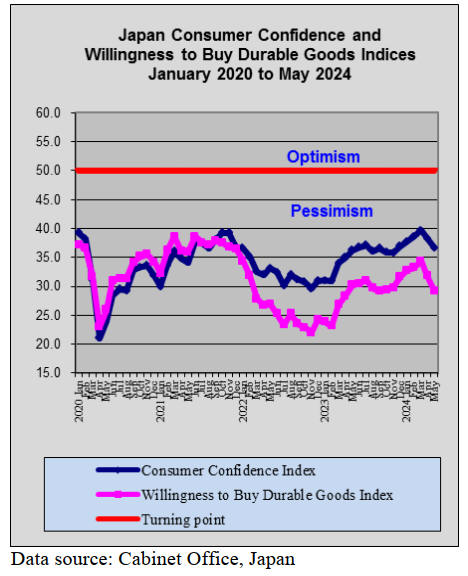
Yen exchange rate buffeted after GDP data
released
The Japanese yen edged lower in early June as the US
dollar strengthened and the yen exchange rate was further
buffeted when the first quarter GDP figures were released.
After the Bank of Japan (BoJ) announced a slowdown
in
its massive Government bond purchases, the prelude to a
move away from quantitative easing, the yen was down
slightly at 157 against the US dollar. The BoJ decision was
largely anticipated and had little impact on the yen
exchange rate which lingers at historic lows.
See:
https://www.asahi.com/ajw/articles/15305387
In other currency news, Japan will issue new banknotes in
July this year in the first redesign for 20 years. The
banknotes feature as an anti-counterfeiting measure the
world’s first three-dimensional holograms that make the
portraits on bills appear to rotate when tilted. Tactile
marks allow the visually impaired to identify the
denominations.
From the time that they are issued, the new banknotes will
be available from financial institutions and ATMs.
Currently issued banknotes will continue to be legal
tender.
See:
https://www.nippon.com/en/news/p01958/
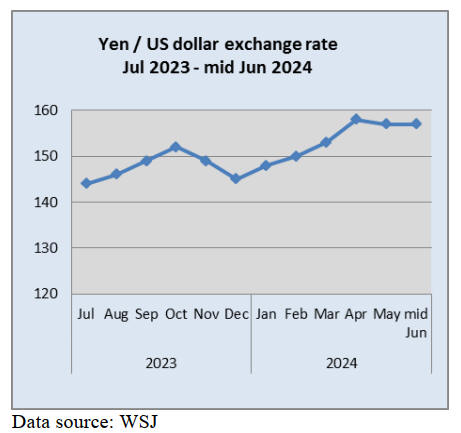
Vast divide between urban and rural housing
trends
Real estate prospects in Tokyo for 2024 are looking bright
according to a survey by Mitsubishi UFJ Trust and
Banking. Prices for newly built condominiums in Tokyo's
23 wards are continuing to rise by about 7% annually.
Properties priced over 60 million yen are expected to
experience a substantial 8% surge in value. Conversely,
properties priced under 60 million yen are forecast to see a
slightly lower but still significant increase.
See:
https://www.e-housing.jp/post/2024-property-investment-forecast-in-japan-according-to-experts
In contrast to the upbeat Tokyo market there is a surplus of
vacant home in rural areas driven by demographic
changes. As the population ages and younger generations
move to urban centres for better job prospects and modern
lifestyles rural areas are left with a declining population
and empty homes.
The Japanese government has recognised the need to
address this issue and many regional governments have
introduced initiatives to promote the utilisation of vacant
houses. Local governments often provide grants, tax
breaks and low-interest loans to buyers willing to renovate
and live in or rent out these properties.
See:
https://goconnect.jp/2024/06/02/the-investment-opportunity-in-japans-abandoned-rural-houses/
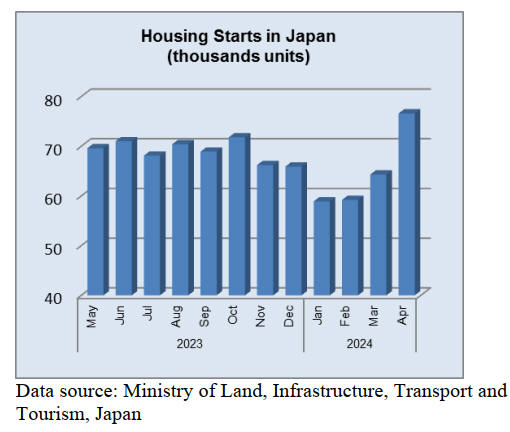
Addressing the root cause of cedar pollen
allergy
Japan is forging ahead with efforts to tackle cedar pollen
allergy which is said to affect 40% of the population. In
May 2023, Prime Minister Kishida held the second
Ministerial Meeting on Pollen Allergy and the participants
engaged in discussions and agreed on the aim to reduce
cedar pollen by 50% by 2053. This will be achieved by
accelerating the felling plantation cedar forests and
replanting with species that produce less pollen.
The report to the meeting noted that artificial forests
created after the end of World War II to conserve land and
meet growing demand for timber are reaching a stage
where the trees can be felled and used. It was pointed out
that it is necessary for the entire society, including
consumers, to work to reinvigorate timber demand.
See:
https://english.kyodonews.net/news/2024/06/f6f593deb21a-japan-to-replace-cedars-with-low-pollen-trees-to-tackle-hay-fever.html?phrase=Costa%20Atlantica%20&words=
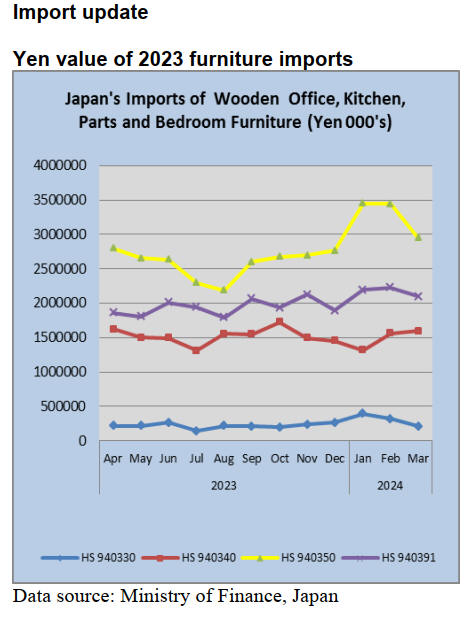
The prolonged weakness of the Yen against the US dollar
continues to drive up the cost of imports and drive down
discretionary purchases by Japanese households and these
factors have negatively affected imports and consumption
of wooden furniture.
March wooden office furniture imports (HS 940330)
In March China and Malaysia were the top two shippers of
wooden office furniture (HS940330) to Japan, accounting
for almost 90% of total March arrivals.
The value of exports of HS940330 from China to Japan in
March dropped sharply (-40%) from a month earlier. On
the other hand the value of shipments from Malaysia
surged three fold to account for a record high of 116% of
Japan’s March wooden office furniture import values.
The other significant shippes of HS940330 in March were
Indonesia and Vietnam.
Year on year the value of Japan’s imports of wooden
office furniture in March 2024 were some 20% below that
of March 2023.
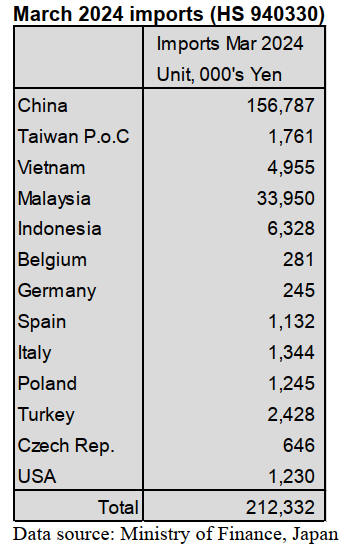
March 2024 kitchen furniture imports (HS 940340)
Year on year, the value of imports of wooden kitchen
furniture items (HS940340) in March fell around 10% but
rose slightly compared to the value of February imports.
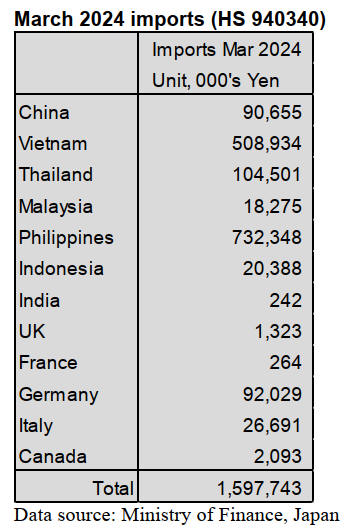
The top shippers were the Philippines, accounting
for
about 46% of the value of March imports followed by
Vietnam at 32% and Thailand 6.5%. The value of
shipments from the Philippines rose in March compared to
a month earlier while shipments from Vietnam were little
changed from the value of February shipments.
The top three shippers accounted for around 85% of the
value of March imports, other significant shippers were
Germany and Italy which together accounted for 7% of the
value of imports.
February marked a rebound in the value of arrivals
of
wooden kitchen furniture to Japan and the slight upswind
in the value of March arrivals built on the February figure.
March 2024 wooden bedroom furniture imports (HS
940350)
After five consecutive monthly increases in the value of
wooden bedroom furniture (HS930350) the value of
February imports steadied but there was a major
downward correction in March. Year on year, the value of
March imports were down 19% and there was a 14%
month on month drop in the value of imports. China
accounted for almost 60% of the value of March imports
toJapan followed by Vietnam at 34% and Malaysia at 4%.
The big losers in March were Vietnam, where the value of
arrivals dropped over 30% and Malaysia, where the value
of imports was down around 40% compared to February.
China remained the top supplier in March and the value of
imports was around the same level as in February.
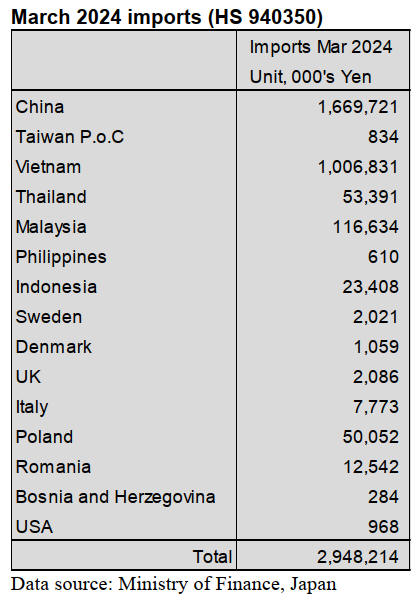
March 2024 wooden furniture parts imports (HS
940391)
Shippers in just four countries, China, Indonesia Malaysia
and Vietnam accounted for 80% of the value of March
imports of wooden furniture parts. Suppliers in China
accounted for around 40% of March arrivals followed by
Indonesia at 16%, Malaysia 12% and Vietnam 10%.
Compared to the value of February imports the value of
March imports from China were down around 14% and
there was a 25% decline in the value of imports from
Vietnam while the value of March arrivals from Indonesia
and Malaysia were at around the same level as in
February.
In March there were 15 member states of the EU and
the
UK that shipped wooden furniture parts to Japan,
however, the combined value of these shipments
represented just 8% of Japan’s March imports of furniture
parts.
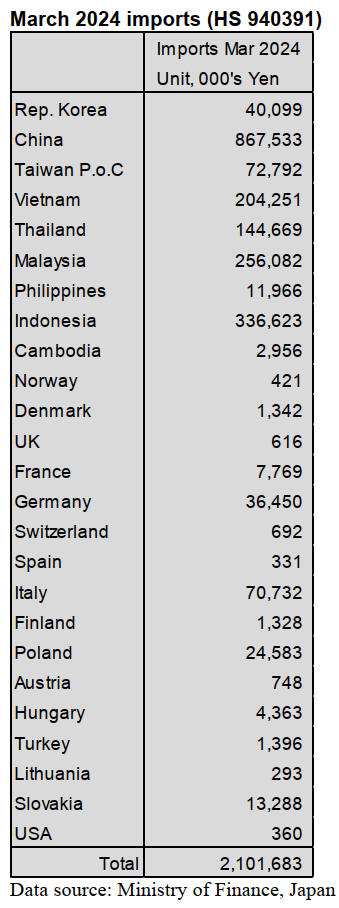
Trade news from the Japan Lumber Reports (JLR)
The Japan Lumber Reports (JLR), a subscription trade
journal published every two weeks in English, is
generously allowing the ITTO Tropical Timber Market
Report to reproduce news on the Japanese market
precisely as it appears in the JLR.
For the JLR report please see:
https://jfpj.jp/japan_lumber_reports/
Plywood
Plywood manufacturers in Japan announced to raise the
price of structural softwood plywood in April and May,
2024 and the plywood price stopped decreasing. On the
other hand, the orders to precutting plants in May are low
and demand for houses is not recovered yet.
12 mm 3 x 6 domestic structural softwood plywood from
major plywood manufacturers costs 1,300 yen, delivered
per sheet.
However, the price of structural softwood plywood in
the
Metropolitan area is around 1,280 yen, delivered per sheet.
Some plywood manufacturers will raise the plywood price
again because the price of glue has been increasing.
For South Sea plywood, the price of 12 mm plywood has
increased after May, 2024. Since the inventory of South
Sea plywood in Japan has been decreasing, major plywood
manufacturers in Malaysia raised the 12 mm plywood
price by US$20, C&F per cbm in May, 2024.
The price of 12 mm 3 x 6 painted plywood for concrete
form in May was around US$650, C&F per cbm.
Structural plywood was US$560 – 570, C&F per cbm.
Form plywood was US$560 – 580, C&F per cbm. If the
price of painted plywood for concrete form rose by
US$20, C&F per cbm, the import cost would be 2,200
yen, FOB per sheet, calculated by 156 yen against the
dollar.
There are not enough logs in Indonesia and some
Indonesian plywood manufacturers expect to raise the
plywood price but the plywood price at this time was
leveled off from the previous time. 2.4 mm 3 x 6 is around
US$950, C&F per cbm. 3.7 mm 3 x 6 plywood is around
US$880, C&F per cbm. 5.2 mm 3 x 6 plywood is around
US$850, C&F per cbm.
The price of 2.5 mm plywood in Japan is 780 yen,
delivered per sheet. 4 mm plywood is 1,000 yen, delivered
per sheet. 5.5 mm plywood is 1,170 – 1,200 yen, delivered
per sheet.
The price of structural plywood / form plywood is 1,750
yen, delivered per sheet. 12 mm 3 x 6 painted plywood for
concrete form is 1,950 yen, delivered per sheet.
How do we face the weak yen?
The interest rate differentials between Japan and the U.S.
have been influencing the yen. The yen was 150 yen
against the dollar at the beginning of 2024 and the yen was
once 160 yen against the dollar.
Since the new starts have not stopped decreasing, wood
industry and building materials industry have been
struggling with this situation. It is hard to find a solution to
recover in the new starts. The yen depreciated to 150 yen
against the dollar last autumn.
Some building materials companies had already raised the
selling price of building materials at that time. Many
Japanese buyers were concerned about the price hike of
imported lumber and imported plywood due to the weak
yen but the actual demand for lumber or plywood was not
enough so the lumber market was weak.
KD domestic studs or ceiling joists became price
competitive. However, the movement of cedar posts,
cypress posts and cypress foundations were sluggish so the
lumber price kept decreasing. On the other hand, the log
price incrased.Exporting domestic logs and domestic
lumber would be good due to the weak yen.
However, people wonder whether exporting domestic logs
and domestic lumber would be a good opportunity to
promote the use of domestic lumber in Japan in the future.
If the volume of imported lumber continued to fall, there
would be no diversity of lumber in Japan. It seems that it
is the end of a period for low-priced imported lumber.
|